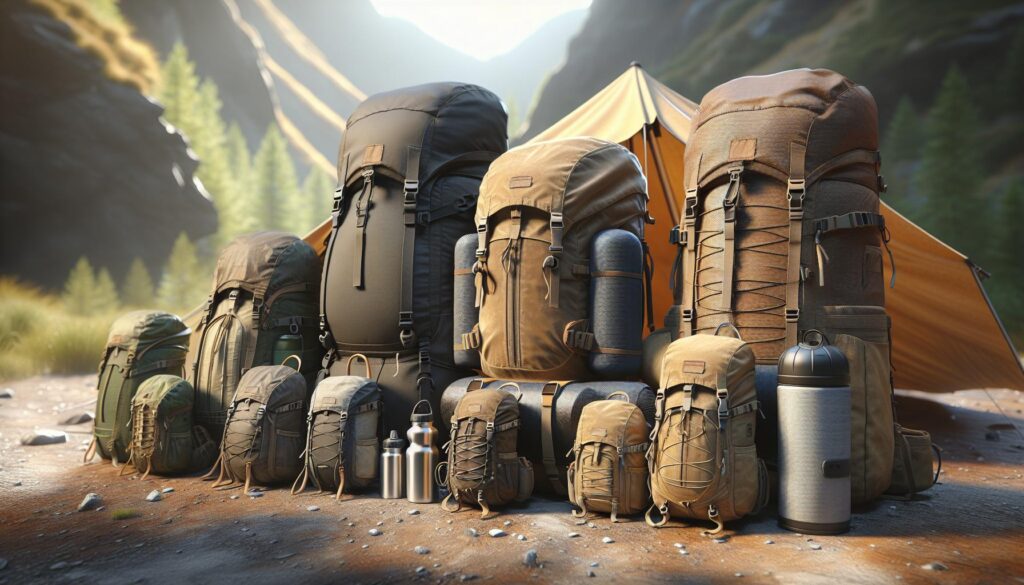Embarking on a hiking adventure? The size of your backpack can make or break your experience. For day hikes, a 20-30L backpack is typically sufficient, while multi-day trips may necessitate a 40-70L backpack or larger, depending on the season and additional equipment required.
Table of Contents
Why the Right Backpack Size Matters
Choosing the right size for your hiking backpack is a critical step towards a comfortable and enjoyable outdoor adventure. The comfort and fit of your backpack are paramount. A backpack that’s too small can cause discomfort and restrict movement, while an oversized one can put excessive strain on your back and shoulders.
A well-fitted backpack plays a crucial role in reducing strain and injury. By evenly distributing weight across your body, a properly sized backpack minimizes the risk of muscle fatigue, back pain, and other potential injuries from carrying heavy loads. Plus, a well-fitting backpack ensures stability and balance, preventing accidents on tricky terrains.
Another key consideration is the capacity to carry essential gear. Depending on the length and difficulty of your hiking trip, you need enough space to pack essential items such as food, water, clothing, and camping gear. Choosing a backpack with the right capacity ensures you can comfortably carry all necessary items without overburdening yourself.
Determining the Right Backpack Size: Key Factors
Several factors come into play when determining the size of a hiking backpack. First, consider the duration of your trip. A shorter trip may require a smaller backpack, while a longer trip will likely require a larger one to accommodate extra gear and supplies.
Season and weather conditions also influence the size of your backpack. If you’re hiking in cold weather or during the rainy season, you may need to pack extra layers and gear, necessitating a larger pack.
The type of hike you’re planning is another crucial factor. A day hike will require a smaller pack compared to a multi-day hike or backpacking trip.
Lastly, consider the personal items and gear you’ll be taking with you. If you have specific items or gear that are bulkier or heavier, you may need a larger backpack to accommodate them.
Assessing Your Gear and Supplies
When determining the size of your hiking backpack, it’s crucial to assess your gear and supplies. Start by evaluating your clothing and footwear needs. Consider the weather conditions and pack accordingly, opting for lightweight and moisture-wicking options.
Next, review your sleeping gear and shelter requirements. A tent or hammock with an appropriate sleeping bag and pad is essential for a comfortable night’s sleep.
For cooking and food, select lightweight cookware and bring dehydrated meals or food that’s easy to prepare on the trail. Don’t forget to pack a fuel source such as a stove or firestarter.
Hydration and water storage are vital for hiking. Carry a water filter or purification tablets to ensure access to clean water. Hydration bladders, water bottles, or collapsible containers can help you stay hydrated on the trail.
Lastly, ensure you have navigation and safety equipment. Bring a map, compass, or GPS device for navigation. Additionally, pack a first aid kit, headlamp, whistle, and emergency blanket for safety purposes.
Estimating the Total Weight of Your Gear
When estimating the total weight of your hiking gear, it’s important to evaluate the weight of individual items. This will help you determine the base weight and the weight of consumables you need to carry. Consider the weight of your tent, sleeping bag, and sleeping pad. Look at the weight of your stove, cookware, and food. Don’t forget to account for the weight of your clothing, water, and personal items such as a first aid kit and toiletries. Once you have evaluated the weight of each item, you can calculate your base weight, which includes everything except consumables. Consumables include items like food, water, and fuel, which will fluctuate throughout your hike. By estimating the total weight of your gear, you can determine how big of a hiking backpack you will need.
Choosing the Right Backpack Capacity Range
When selecting a hiking backpack, the capacity range plays a crucial role in ensuring a comfortable and organized outdoor experience. Determining the appropriate backpack size depends on the duration and intensity of your hiking trips as well as your personal needs. Here are the three main categories to consider:
| Daypacks (20-35 liters) |
| Perfect for day hikes and shorter outdoor adventures, daypacks offer enough storage space for essentials like water, snacks, extra layers, and a first aid kit. |
| Overnight Backpacks (35-50 liters) |
| Slightly larger than daypacks, overnight backpacks can accommodate clothing, gear, and food for an overnight or weekend trip. |
| Multi-day Backpacks (50+ liters) |
| Designed for longer backpacking trips or multi-day adventures, these backpacks provide ample space for all your gear, including sleeping bags, cooking equipment, and clothing. |
By evaluating the duration and objectives of your hiking trips, you can confidently select a backpack with the appropriate capacity range, ensuring optimal comfort and organization throughout your outdoor excursions.
Measuring Your Torso Length
When choosing a hiking backpack, it’s crucial to determine the correct size to ensure maximum comfort and functionality during your outdoor adventures. One key measurement is your torso length, as backpacks are designed to align with different torso lengths for optimal weight distribution.
To accurately measure your torso length, follow these steps:
- Stand up straight and tilt your head slightly forward. This helps align your neck and spine in a natural position.
- Locate the bony bump at the base of your neck, which is typically the highest point of your shoulders.
- Place your hands on your hips with your thumbs pointing towards your back.
- Using your fingers, feel for the top edge of your pelvic bone. This point is usually slightly higher than your belly button.
- Measure the distance between the bony bump at the base of your neck and the top edge of your pelvic bone. This measurement corresponds to your torso length.
Once you have your torso length, refer to a sizing guide provided by the backpack manufacturer to find the appropriate backpack size range for your measurements. It’s important to note that different brands may have slight variations in their sizing guides, so always refer to the specific manufacturer’s recommendations.
Adjusting Shoulder Straps and Hip Belt
Adjusting shoulder straps and hip belt are crucial steps in ensuring the proper fit and comfort of your hiking backpack. When it comes to shoulder strap adjustment, start by loosening all the straps completely. Put on the backpack and tighten the shoulder straps evenly, ensuring that they are snug but not too tight. The straps should securely wrap around your shoulders and distribute the weight of the backpack evenly.
Now, let’s focus on the hip belt adjustment. Loosen the hip belt and buckle it around your waist, just above the hip bones. Tighten the belt ensuring a snug fit. The hip belt should bear most of the weight from the pack and should be positioned comfortably on your hips. Adjust the tension as needed.
Remember, a properly adjusted hiking backpack will reduce strain on your shoulders and back, allowing for a more enjoyable and comfortable hiking experience. Take the time to adjust the shoulder straps and hip belt whenever you put on your backpack for an optimal fit.
Testing and Fine-tuning Backpack Fit
Testing and fine-tuning backpack fit is crucial to ensure a comfortable and well-supported hike. One important aspect is carrying and walking with a loaded pack. It’s important to check balance and comfort while carrying your backpack. Distribute the weight evenly and adjust the straps to achieve proper balance. Walk around and see if there are any pressure points or discomfort. Making necessary adjustments to the shoulder straps, waist belt, and load lifters can help fine-tune the fit and alleviate any discomfort.
Frequently Asked Questions About Hiking Backpack Sizes
What Size Hiking Backpack Do I Need For A Day Hike?
For a day hike, a backpack with a capacity of around 20 to 30 liters should be sufficient. This size will allow you to carry all necessary items like water, snacks, extra clothing, and a first aid kit without weighing you down.
How Big Of A Hiking Backpack Do I Need For An Overnight Trip?
For an overnight trip, you’ll need a larger backpack with a capacity of 35 to 50 liters. This size will provide enough space for your sleeping bag, tent, clothes, food, water, and other essential gear. It’s important to consider the length of your trip and the amount of gear you’ll be carrying.
What Size Hiking Backpack Is Suitable For A Multi-day Trek?
For a multi-day trek, you’ll need a backpack with a capacity of 50 liters or more. This size will allow you to carry all your gear, including a sleeping bag, tent, cooking equipment, food, water, and extra clothing. It’s important to choose a backpack with a comfortable fit and adjustable straps for long trips.
Is A Bigger Hiking Backpack Always Better?
Not necessarily. While having a larger backpack can provide more storage space, it can also be heavier and bulkier. It’s essential to choose a backpack that matches the length and type of your hiking trips. Finding the right balance between capacity and comfort is key for an enjoyable hiking experience.
Conclusion
To ensure a successful hiking trip, choosing the right size backpack is crucial. Consider factors like the duration of your hike, the items you plan to carry, and your personal comfort level. By finding the optimal balance between capacity and weight, you can enjoy your adventure with ease and convenience.
Remember, a well-fitted backpack will enhance your hiking experience, making it more enjoyable and memorable. So, take the time to select the proper size and gear up for your next outdoor adventure.














